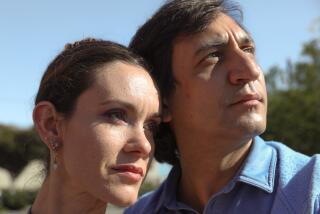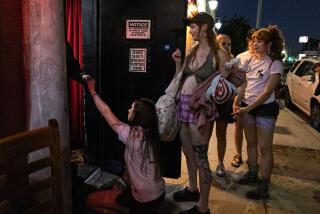Theodore Kosloff cut a fouette figure
One hundred years ago, on May 19, 1909, Serge Diaghilev’s Ballets Russes debuted in France and redefined dance for the 20th century. Toiling for le tout Paris in front of the hot footlights of the Théâtre du Châtelet were ballet superstars Vaslav Nijinsky and Anna Pavlova -- artists whose names resonate around the world.
Among this galaxy of luminaries, however, only one was destined to achieve his fame in Los Angeles, where today he is all but unknown. The 27-year-old powerhouse was known then as Fedor Mikhailovich Koslov. Here, he was Theodore Kosloff.
Named for Dostoyevsky, this deeply artistic and ambitious Muscovite was also a proficient painter and violinist. But within a decade of his Ballets Russes debut, he abandoned the constrained and hierarchical world of Russian ballet for the clean slate of Southern California, where he became a ballet pioneer starting in 1916.
Kosloff’s efforts to promote ballet in L.A. stretched over decades: He ran schools, trained dancers, performed in vaudeville and was a key producer at the Hollywood Bowl. The 7-acre dacha he built in Sunland boasted wood-carved interiors, an indoor-outdoor pond, a gazebo, kennels and a six-car garage.
How did Kosloff -- danseur noble, superb pantomimist, partner of Tamara Karsavina and a technical virtuoso who could toss off 18 pirouettes in succession -- become L.A.’s Ballets Russes go-to guy? He reinvented himself as a dashing screen presence, a member of Cecil B. DeMille’s stock company and a cog in the Paramount Pictures publicity machine . . . all while clinging to his identity as a dispenser of undiluted Russian culture.
Kosloff is known in the ballet world for one striking credential: He was Agnes de Mille’s first coach. DeMille’s dance-besotted 13-year-old niece had begged her family to let her study ballet after being thunderstruck at age 8 by the sight of Pavlova. At her audition in 1918, Kosloff scathingly deemed the ungainly Agnes to have “no juice.” She was undaunted, of course, and later, as a great Broadway and ballet choreographer, she always credited Kosloff with giving her her start.
Free ballet classes for his niece were DeMille’s quid pro quo for putting Kosloff into the movies. Jeanie Macpherson, DeMille’s longtime collaborator and screenwriter, had studied ballet with Kosloff in New York around 1911. Five years later, teacher and pupil had a backstage reunion at L.A.’s Orpheum-circuit vaudeville theater, where Kosloff was presenting such gems as his 15-minute quickie version of “Giselle.”
Introduced to the Russian by Macpherson, DeMille recognized in Kosloff’s brooding mien, bohemian thatch of hair and catlike way of moving the perfect Aztec dancer for his Geraldine Farrar vehicle “The Woman God Forgot” (1917).
As dazzled by the movies as the next guy, Kosloff did his first film on a lark. A star may not have been born, but a versatile character actor was. Throughout the 1920s, Kosloff appeared in a string of 26 Famous Players-Lasky/Paramount silent features.
“Grandfather liked Kosloff and trusted him very much,” says Cecilia DeMille Presley, the filmmaker’s granddaughter.
Long after their silent-film collaboration had ended, DeMille again engaged Kosloff for the 1949 “Samson and Delilah.” Kosloff staged the ceremonial dances in the Philistine temple where Samson’s capture is celebrated -- before Victor Mature’s biceps turn the place to rubble.
A.C. Lyles, Paramount’s renowned producer-publicist, recalls Kosloff’s untouchable status at the studio during the silent era: “The thing that was important in Theodore Kosloff was his closeness to DeMille. DeMille admired him. Everyone knew about it. That was a very big plus for him. Agnes de Mille championed him, and Jeanie Macpherson was his contact.”
Over their long association, DeMille also paid Kosloff well for his talents. Kosloff, for his part, was clever, or lucky, enough to take Paramount stock in lieu of salary early on. And having invested wisely in L.A. real estate, the onetime starving artist became an arts entrepreneur. He ran multiple ballet schools around town and in the late ‘20s franchised his brand nationally with Kosloff studios in Dallas, San Francisco and Chicago. He coached stars in movement, fencing, pantomime and specific dances.
Not the talkie type
Kosloff’s longest exposure as a dancer in movies is a three-minute interlude in DeMille’s bizarre early talkie “Madam Satan.” He starred as “Electricity” in a ballet mécanique performed aboard a zeppelin. But after this 1930 film, Kosloff’s movie career was effectively over. With the coming of sound, audiences couldn’t understand his heavy Russian accent or his mangled English-language syntax.
“I always thought he faked that accent and mixed up words for effect. I think he knew exactly what he was doing,” says Lyles. Kosloff’s voice can be heard in the 1937 comedy-drama “Stage Door.” Playing a chorus line rehearsal director, he claps his hands in the direction of showgirls Ginger Rogers and Lucille Ball and says, “All right, all right. That’s enough for today,” adding, “Go to home.”
After talkies betrayed him, Kosloff still had his teaching. He epitomized the old-school ballet master. To keep rhythm, Kosloff pounded the studio floor with his heavy stick. When his volcanic temper erupted, he used the stick to smack students. In a sweeter mode, this son and grandson of classical musicians accompanied class on his fiddle.
“That was an old Russian custom. Ballet teachers would never sit behind a piano. They stood, accompanying on violin,” says Victor Anderson, an instructor at the Shawl-Anderson Dance Center in Berkeley who studied with Kosloff in his teens.
As it happened, Anderson’s teacher in San Francisco, Maria Baldina, was Kosloff’s estranged wife. “I was about 17 -- it was the late 1940s. Baldina told me to go to L.A. and take class with Mr. Kosloff. I went down there and stayed with my grandmother. I took a streetcar to his studio on Hollywood Boulevard.”
Kosloff commanded attention, Anderson recalls: “He was a powerful man -- he wasn’t tall, but he gave the feeling of being tall. . . . He was serious. He had those Tatar eyes, the most penetrating eyes I ever saw in my life. If he looked at you, you gave him what he wanted.”
Dance scholar Naima Prevots, author of “Dancing in the Sun: Hollywood Choreographers, 1915-1937,” says: “Kosloff was a matinee idol -- he played it for what it was worth. I don’t think he fudged on his teaching, though. He stuck to the tradition and taught well. He respected the tradition enormously.”
Kosloff also staged ambitious opera and ballet pageants in the 1930s at the Hollywood Bowl and Shrine Auditorium. He presented uncredited versions of Fokine’s choreography: “Schéhérazade,” “Cléopâtre” and “Les Sylphides,” which he recycled as “Chopin Memories.” Throughout his career, dating to his vaudeville days, he borrowed heavily from material he clearly saw as his to pilfer.
“I don’t fault him,” says Prevots. “That was the world then. Kosloff came to Los Angeles to make money. It wasn’t so easy. If he did a little monkey business, well, who knew about Diaghilev in Los Angeles -- maybe five people? Soon Diaghilev was gone.”
Complicated maneuvers
Kosloff was always a ladies’ man. Ballerina Tamara Karsavina wrote in her memoir, “Theatre Street,” that she and fellow dancer Lydia Lopokova vied for his attention in the Ballets Russes. But the lanky and elegant Baldina, yet another dancer, won out. Kosloff did the right thing after getting her pregnant (their sickly daughter died young). But it was an unhappy marriage made worse by Kosloff’s open philandering with ballet girls.
Early in the marriage, about 1914, with Baldina and the baby still tucked away in England, Kosloff hooked up with an exceptionally beautiful and well-bred 17-year old student named Winifred Shaughnessy. Renaming the arty Winifred as Natacha Rambova, he clashed with her in a tempestuous, sexually charged four-year relationship. In a feminist’s nightmare, he even took credit around Hollywood for Rambova’s sumptuous costume and set designs. The fed-up Rambova finally packed her bags one Sunday and ordered a taxi. Kosloff surprised her by returning early to their Franklin Avenue home after a weekend expedition at DeMille’s Tujunga ranch. A quarrel ensued, and he shot Rambova in the leg with his hunting rifle. Rambova, bleeding, escaped through a window. She soon married the gorgeous hunk Rudolph Valentino.
Over time, the Kosloff in photos appears increasingly dour; there is a puffiness indicating an over-fondness for vodka. He died in 1956, age 74, leaving no heirs to his dream retreat, deep in the San Fernando Valley, filled with objets d’art: a necklace and castanets that had belonged to Pavlova, a baby grand played by Rachmaninoff. No one seemed interested in any of it. In 1957, his attorney placed a classified ad hawking the whole kit and caboodle for $175,000. For years, there were no takers.
Today only remnants of Kosloff’s manic Los Angeles life and his artistic circle exist, although the Sunland property was on the market as recently as 2006. But Hollywood of the 1920s is enjoying a cultural, design and architectural revival.
Kosloff, in any case, succeeded where his later compatriots Nureyev and Baryshnikov did not. He was a ballet dancer who enjoyed a durable career acting in movies. And he gave the world the gift of Agnes de Mille. Like Norma Desmond in “Sunset Boulevard,” Theodore Kosloff was big. It was the pictures that got small.
More to Read
The biggest entertainment stories
Get our big stories about Hollywood, film, television, music, arts, culture and more right in your inbox as soon as they publish.
You may occasionally receive promotional content from the Los Angeles Times.





